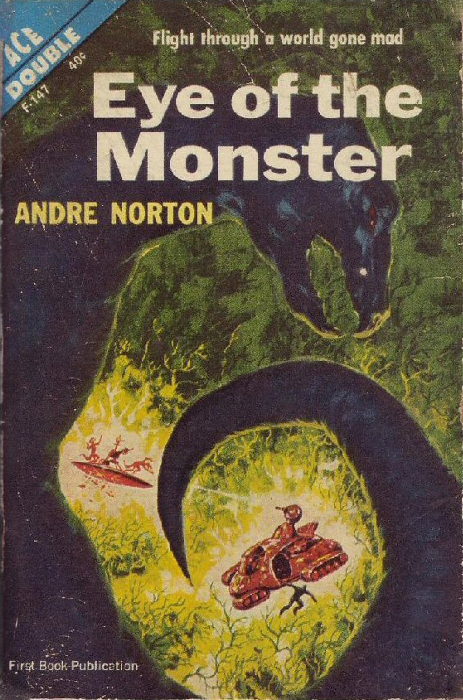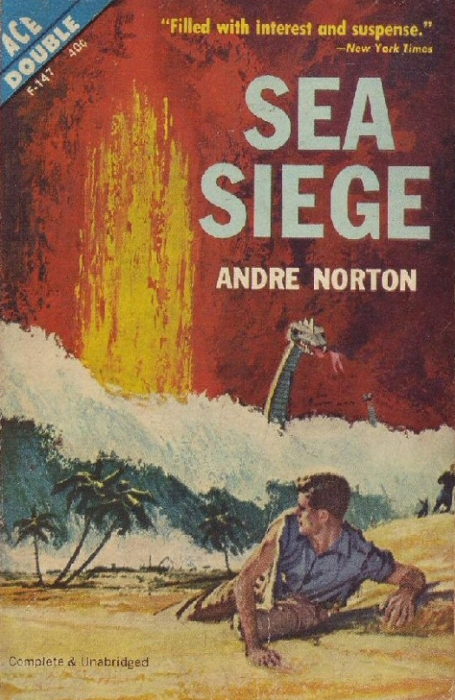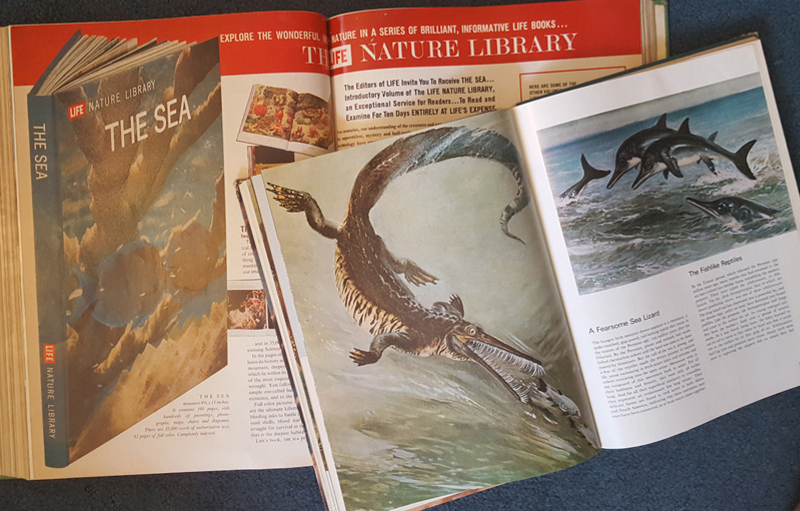[if you’re new to the Journey, read this to see what we’re all about!]

by Gideon Marcus
Science fiction is often profound. It provides cautionary tales; it explores thorny social issues that are difficult to discuss without metaphor; it glimpses the future.
But much of the time, science fiction is just an escape, a genre ripe for stories of adventure. The vast frontiers of space or under the sea or the frozen arctic wastes have been the setting for countless such tales since the dawn of the Pulp Era.
The prolific Andre Norton had made this type of story her stock in trade. Whether set in a fantasy world, an historical setting, or in a far-flung galactic tableau, her works typically feature a young man gallivanting in a rough-and-tumble environment, surviving by virtue of wit and physical exertion.
American publishing house, Ace Books, also makes this fare its bread and butter. They are perhaps best known for their "Ace Doubles:" For 45 cents, you get not one, but two short science fiction novels. These are often novelized serials from sf magazines. Occasionally, they are purpose-written pieces. Some are subjected to unfortunate edits to cram them into the 250-page format. In short, Ace is something of a bargain-basement venue — the pulps of the book world, if you will.
Ace and Norton are, therefore, something of a match made in heaven. The recent Ace Double, F-147, features two Norton pieces back to back, one reprint novel and one new novella. While it's nothing to write home about, it will keep you entertained on a long round-trip car, boat, or plane ride.

The novella half of F-147 is strongly influenced by the recent decolonization in Africa. Monster stars Rees Naper, a teenager whose world is turned upside down when the reptilian inhabitans of Ishkur revolt against the Terran inhabitants upon the withdrawal of colonial police protection from the planet. Towns are razed, laboratories smashed, religious missions demolished. Naper must make a perilous trek across a treacherous jungle landscape in an armored transport. His goal is simple: to save his own life as well as those of a colonist boy and two female Salarkans (one mature, one a child), feline traders from another star. Can he make it to the better-protected starport before the Ishkurians find him?
Two factors, one positive and one negative, make this exciting but rather ordinary piece of adventure stand out.
On the plus side, I greatly appreciated the character of Ishbi. The resourceful Salarkan is as important to the story as Rees, tough and competent. Moreover, there isn't a shade of romance; just two resilient refugees overcoming obstacles. I suspect that Norton made Ishbi an alien explicitly for the purpose of ensuring that there could be a male/female relationship on a platonic, equal basis.
The natives of Ishkur don't make out so well. Replace Ishkurians with Africans and you've got a dead ringer for a tale of noble White settlers and savage Blacks in the Dark Continent. What a far cry from Reynold's nuanced Mahgreb series, recently published in Analog. It would not have taken much to add dimension to the story; instead, it comes off as insensitive.
Nevertheless, it is a good read, and though the Ishkurians get a shallow, bigoted (by analogy) portrayal, the character of Ishbi is a bright light in a genre dominated by men. Three stars.

This novel was originally published five years ago, and it feels older. The exotic locale for Monster was an Africa analog; for Sea Siege, it is the tiny sun-baked West Indies isle of Santa Isadore. Our hero this time is a young man improbably named "Griff Gunston," son of a famed icthyologist. As a frequent diver, he notices an increasing number of queer events: patches of "Red Plague," a radioactive and toxic algae, are spreading across the sea; octopi are displaying greater intelligence and menacing behaviors; ships are disappearing, rumored to have been sunk by sea serpents!
Amidst all this, Cold War tensions are ratcheting up. A detachment of American "Seabees" arrives to construct an atomic-powered supply base. The island's natives, disconcerted by recent events and resentful of the disturbances they blame on the outsiders, become restive. Just as the frequency of lost divers and vessels reaches a fevered pace, nuclear war breaks out between the superpowers. Continents are torn asunder, new volcanoes are spawned, and Santa Isadore is wracked with geological spasms.
End Part One.
The second half of the novel is a tale of survival in a world gone mad. The weather is freakish as caustic winds lash the island, culminating in a ravaging storm. Worse, whether spurred by radiation-induced mutation or the atomic rupture of the deeps, the ocean has turned against the land-dwellers: octopi-sapiens and their sea serpent thralls make the waters uninhabitable, capsizing ships and snatching people from the beaches. But the ingenuity of humanity, enabled by both the advanced atomic-fueled science of the navy personnel and the native lore of the islanders, wins the day. At least temporarily.
Part Two ends with a number of untied threads: Will the increasingly hostile Santa Isadoreans continue to abide the American soldiers? Can there be a meeting of the minds between people and the cephalopod terrors? Are there any centers of population left in the rest of the world?
Sadly, there is no Part Three. If you want to know what happens, you'll have to make it up.
This is part of what makes Sea Siege a strange book. It takes rather long to get started, a good deal of time spent on Griff's undersea adventures. Things don't really move until the mid-point; Part 2 is briskly paced. Because of the plodding set-up and all the unresolved questions, one can't help but think that Norton meant to write a third part, but just never got around to it.
Norton's novel is also unusual when viewed side-by-side with the other post-apocalyptic books of the time, e.g. On the Beach and Alas, Babylon. One starts Sea Siege with the impression that, like those books, it is going to be a gritty, realistic story. The departure into scientific fantasy, while not inexpertedly handled, feels odd.
Par for the course with Norton, there is an interesting and diverse cast of characters. The islanders are depicted with dignity; in fact, there is a strong suggestion that their unique technologies and reactionary mindset are a necessary yin to the yang of the headstrong and arrogant foreigners, whose hubris ultimately led to the Earth's near destruction. And it is clear that Norton has done her homework: her depiction of the Caribbean is evocative, highly sensual, and at times reads like a lightly fictionalized transcription of LIFE's recent picture-book, The Sea.
All in all, it is a pleasant if slightly unsatisfying read, particularly if you enjoy it as I did — accompanied by Harry Belafonte's hit record, Calypso. Three stars.

—


While I think these are both poor samples of Norton, I wouldn't read the Ishkurians as Africans, or any sort of humans. Norton goes back to a time when scaly, bloodthirsty aliens stood for scaly, bloodthirsty aliens. I agree Sea Seige is very unsatisfying, but not only because of the ending. She often does that sort of open ending. Myself, I find the inimical nonhumans too cardboard in both cases and would have preferred both stories without them.
You may be right regarding Monster — the cigar may just be a cigar.
As someone who likes and is fascinated by octopi, I really wanted to learn more about the new brainy kind. And, I also prefer my post-nuclear stories sans monsters.
Thanks for reading.
Boy , Ace doubles were a godsend to me and my fanish friends starting in 1954. We were aware that there were hard bound SF novels on the shelves at the Dallas Public Library but they were slow to stock them and not very good at being complete.
In summer of 1954 we discovered Miles used bookstore on Deep Elm in Dallas.
Old Man Miles, coming home after WWII had worked for the Salvation Army sorting donated goods, he took as compensation all the books and magazines. He opened a big store in a shabby shop embedded among a string of pawnshops near downtown Dallas. Twelve-foot ceilings, two floors, the 2nd floor sagged when you walked on it. Books, books, books, stacked to the ceilings. The 2nd floor was our Mecca. Jammed with thousands of copies of Life, Colliers, Saturday Evening Post, Look, on and on. One corner was piled with paperback science fiction. They were all a nickel apiece; I remember the cover prices were 35 cents. We always had a couple of nickels.
That second floor was an adventure, no AC. In August it would be 120 degrees and January it could be 20 degrees. When it was cold Miles ran old gas space heaters with broken ceramics, inches away from dry paper! Hardly keept the place warm. The place would have exploded in a fire.
We were the only ones who went to the 2nd floor.
Top that off with open barrels of poisoned peanut brittle to kill the rats.
Old Man Miles was always talking to a Dallas Fire Inspector most times when we were there, have no idea what that was about!
We loved that crazy bookstore!
First Ace double was Gateway to Elsewhere (Leinster) and The Weapon Shops of Isher (van Vogt). Next I got The 1000 Year Plan by Asimov. Someone remarked that that was really Foundation, which I had never heard of, but quickly found the Gnome press edition and found out Ace had left out the final segment of Foundation! (No World of Their Own , Anderson, was on the other side of that Asimov.) Budget wise Ace was a great source of SF reading, must have a hundred of those on my shelves.
Thank you for that wonderful bit of personal history, Al! Hard to believe that was just eight years ago, when people were already predicting the death of science fiction.
120 degrees in the summer, 20 degrees in the winter — that was El Centro, the tiny desert hamlet where I grew up.
Al is certainly right, though unfortunately I never got to Dallas to see the Miles bookstore. But I do recall the Ace double you write about today, and in fact it's sitting in a stack of Ace doubles inside a cabinet within about four feet of me as I write. Loved Norton in those days and had forgotten how odd Sea Siege really was. Wonderful to see the covers again! And back to Al: Growing up in St. Louis, I can only wish we had as interesting a bookstore as the Miles place. There were some good ones downtown, but nothing loaded up with old magazines and paperbacks to match this!
Great to see you around, Paul. Glad you've read this one, too.
This had been sitting in my to-read pile forever. I just started it today after reading your review. Regarding the sudden ending and other choppy parts, this is certainly one of Norton's quirks as a writer, but when reading Ace doubles you have to remember that although they said complete and unabridged in the cover, the novels were always heavily abridged. Because of the format they needed to fit the books into a pre-set number of pages, so instead of being able to publish the books with the right number of pages to fit the story, they chopped the story up to fit the allotted number of pages.
This always dismays me. That said, I wonder if anyone has the original publication from 1957 and can tell if there be a difference. I'm pretty sure the two versions are identical.
Even if they didn't abridge it, DAW was a notoriously intrusive editor. There's almost always huge differences between the ace double versions and original versions of the novels. But maybe he gave Norton leeway because she was his primary author. I'm curious too though. Maybe there's an entire lost third part!
I had this one for a while — must have given it to a friend. I'd forgotten the abrupt non-ending of "Sea Siege", but now I remember how it bothered me.
I wasn't impressed with either of these (esp. compared to some of her really excellent work) so I guess that's why I gave it away. The bookshelves here are overflowing; no room to keep the bad or mediocre!
Oh, for one of those sci-fi devices where they have an entire library on something that fits in your pocket. Like in that June Analog story, where Telzey Amberdon has her whole law library in her purse.